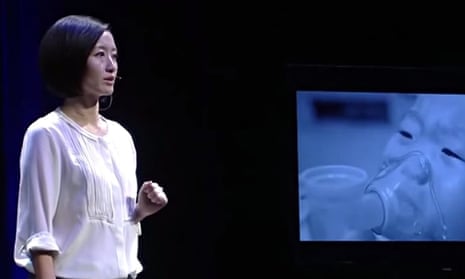A documentary released at the weekend by the Chinese journalist Chai Jing purporting to tell “the truth” about China’s air pollution has caused a national storm, with more than 200 million viewers already. Part of the reason Under the Dome has been hailed such a revelation is that until now the issue of pollution in China has been, in many ways, a closed book. During last year’s Apec summit in Beijing, for example, the government swiftly shut down American embassy readings of PM2.5 (harmful microparticles in pollutants) levels that revealed less than clean air.
Over two hours long, Under the Dome is a comprehensive look at pollution in China and the most high-profile investigation the public has seen. It has wedged open a relatively opaque window on facts and figures, lifted the lid on how lax the system is on polluting industries, and how serious pollution is all across China – not just in the symbolic capital of Beijing.
Chai also highlights those most at risk or worst affected by dangerous pollutants: such as villagers in Shaanxi province, whose lives were engulfed by smoke from nearby coal plants and a six-year-old girl who admits that she has never seen blue sky.
It was an eye-opener for many, particularly given the unprecedented access the journalist gained on the ground. The documentary shows factories breaking regulations and authoritative figures who speak frankly, revealing the scathing truth that rules are simply ignored and that punishment stunts growth and costs people jobs.
As someone living in Beijing who takes precautions when the air quality deteriorates, I’m impressed by how hard-hitting Chai’s documentary is. While watching it, I thought it could be a turning point for the Chinese public’s awareness of the dangers of pollution to health.
While such awareness is growing – particularly in big cities such as Beijing and among the expanding middle class – only a small minority of people take proper precautions. Few wear facemasks outdoors, and even fewer have air filters. In fact, until a year or two ago, you were stared at if you wore a facemask outdoors – the only people who did so were almost certainly foreign. I started wearing one just over a year ago – before that, while I was aware of the health implications, it was easy to be oblivious to smog when you live it day in and day out.
Chai’s documentary has empowered China’s online community to wake up to the dangers of pollution and voice solidarity over this national headache. For three days straight, it was the only topic on China’s social media platforms. But as the nation united – online rather than offline – in its critique of government policy and punishment for the offending organisations, negative reactions to the documentary also surfaced.
Many have accused Chai of a publicity stunt linked to the government and using the film to stir up collective sentiment in time for a planned response to the issue at the annual meeting of the Communist party’s top advisory body, which started on Tuesday.
In all likelihood, something so high profile as Chai’s film could not have been released without formal acknowledgement – or approval – from the higher echelons of government. Others have begun questioning the facts and figures quoted in the documentary – a well-shared blogpost accused Chai of manipulating figures.
And while Chai herself rallied the public to drive change by reporting polluting businesses, there’s no sign yet that civic action is gaining momentum.
Nevertheless, the documentary is at least hitting home on the dangers of PM2.5. It was the reason my cousin, who lives in China’s worst polluted province, Hebei, bought an air filter this week. However, she has no idea whether the one she purchased actually filters PM2.5.
Taking precautions is not as easy as it sounds and may be a barrier for those most at risk. For the educated middle class, the necessary tools are affordable and worth the hassle and inconvenience for the safety of their families. But for the majority, proper precautions are impractical and unrealistic. It’s certainly unaffordable for the villagers living next to polluting coal plants to fork out for a commercial air purifier or even a N96 masks that costs a pound a go. So amid the momentum for change, the poorest may just be left behind.
For anyone who has experienced an “airpocalypse” in China, the difference between a clear and a heavily polluted day is that of night and day. It will take hardline reforms, the implementation of laws and a push from the top of government through to the coal-burning plants to implement change. But even when the head of state makes it a national priority, it will still be a challenge for a country the size of China.
Under the Dome may be galvanising Chinese people to think about pollution, but it remains to be seen whether it will change anything or just be forgotten.
